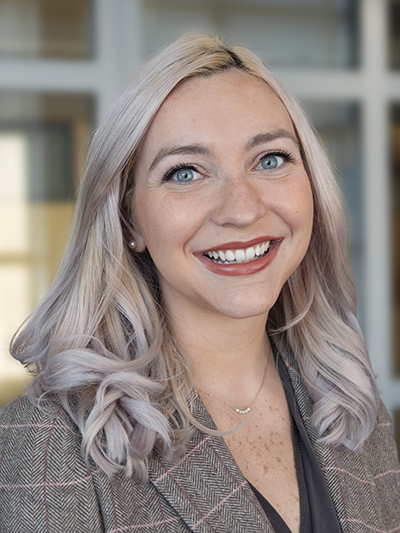
Alexandra E. Paton
she/her/hers
Assistant Professor
PhD, New Mexico State University, 2021
- Office Location
- 410 Hutchison Hall
- Telephone
- (585) 275-2340
- Web Address
- Website
Office Hours: By appointment
Research Overview
Enzymes are nature’s highly refined molecular machines that help build up and tear down the chemicals that interact with all living organisms. Over billions of years, they’ve evolved to be incredibly precise, flaunting control over exactly where and how a reaction takes place. Scientists have discovered around 24 million natural enzyme sequences, making them the largest and most diverse group of catalysts available to scientists. Yet, fewer than 1% of these enzymes have been studied in detail. This represents a vast, untapped resource of selective, sustainable, and mild catalysts for synthetic chemistry.
In the Paton Lab, we’re tapping into this hidden potential. We study enzymes that haven’t been characterized yet, looking for ones that can carry out useful chemical transformations. Our goal is to find better, cleaner ways to make complex scaffolds like those found in medicines or natural products. The selective nature of enzymes enables protecting-group- free transformations, with elite specificity to perform site- and stereoselective C–H functionalization chemistry, under aqueous conditions at or near room temperature. This tool enables streamlined synthesis of complex molecules, making it a highly desirable method in the pharmaceutical and chemical synthesis industries.
To identify and develop these valuable transformations, we combine chemistry, biology, and data science. We navigate dense datasets via machine learning to predict which uncharacterized enzymes can perform valuable transformations beyond the scope of traditional chemical methods. Data science techniques accelerate the biocatalytic reaction discovery process and empower the incorporation of this method in chemical synthesis. With this valuable data in hand, we use synthetic biology tools to enable the production of the enzyme through the culturing of host systems. This provides us with renewable access to precious catalysts, without the need for expensive or laborious catalyst syntheses. Finally, the harvested biocatalysts are investigated for their synthetic utility, illuminating their potential in organic synthetic chemistry.
These catalysts are used to enable the streamlined synthesis of natural products and biologically relevant small molecules. The advancements made in each of these efforts feed back into the three interwoven multi-disciplinary approaches, molding an innovative research program at the forefront of chemoenzymatic synthesis. Work in the Paton lab helps expand the use of enzymes in organic chemistry and builds a foundation for greener, more sustainable methods in complex molecule synthesis.
Research Interests
- Biocatalysis
- Total synthesis
- Data science
- Natural products
Selected Publications
- A. E. Paton, D. I. Boiko, J. C. Perkins, N. I. Cemalovic, T. Reschützegger, G. Gomes, A. R. H. Narayan; Generation of connections between protein sequence space and chemical space to enable a predictive model for biocatalysis. ChemRxiv. 2024; doi:10.26434/chemrxiv-2024-w4dtr.
- J. C. Perkins*, A. E. Golliher*, J. R. Hernández-Meléndez, A. T. Saucedo, J. S. Pyser, A. R. Narayan; Enzyme library-enabled chemoenzymatic tropolone synthesis. ChemRxiv. 2023; doi:10.26434/chemrxiv-2023-lvngd.
- A. E. Golliher, A. J. Tenorio, B. M. Cornali, E. Y. Monroy, R. Tello-Aburto, F. O. Holguin, W. A. Maio; The synthesis and use of γ-chloro enamides for the subsequent construction of novel enamide-containing small molecules. Tetrahedron. 2021, 132536, doi:10.1016/j.tet.2021.132536.
- A. E. Golliher, A. J. Tenorio, N. O. Dimauro, N. R. Mairata, F. O. Holguin, W. A. Maio; Using (+)-carvone to access novel derivatives of (+)-ent-cannabidiol (CBD): the first asymmetric syntheses of (+)-ent-CBDP and (+)-ent-CBDV. Tetrahedron. Lett. 2021, 67, 152891, doi:10.1016/j.tetlet.2021.152891.
- U. K. Shrestha, A. E. Golliher, T. D. Newar, F. O. Holguin, W. A. Maio; The First, Asymmetric Total Synthesis and Revision of Absolute Stereochemistry for (+)-Taumycin A; a Unique Approach that Exploits Orthogonally-Protected Quasienantiomers. J. Org. Chem. 2021, 86, 11086–11099, doi:10.1021/acs.joc.0c02820.
- S. J. Bailey, R. R. Sapkota, A. E. Golliher, B. Dungan, M. Talipov, F. O. Holguin, W. A. Maio; Lewis-acid-mediated union of epoxy-carvone diastereomers with anisole derivatives: mechanistic insight and application to the synthesis of non-natural CBD analogues. Org. Lett. 2018, 20, 4618–4621, doi:10.1021/acs.orglett.8b01909.
